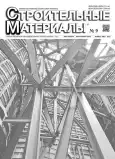Historical aspects of the large-format ceramic stones production
- Авторлар: Uzhahov K.M.1, Lapunova K.A.2, Zemlyanskaya A.G.2
-
Мекемелер:
- Ingush State University
- Don State Technical University
- Шығарылым: № 9 (2025)
- Беттер: 47-54
- Бөлім: Статьи
- URL: https://gynecology.orscience.ru/0585-430X/article/view/693106
- DOI: https://doi.org/10.31659/0585-430X-2025-839-9-47-54
- ID: 693106
Дәйексөз келтіру
Аннотация
Large-format blocks have played an important role in world architecture since ancient civilizations, when they were used in temples and monuments building. The history of architecture, construction and technology study gives possibility tracing changes in architectural styles, types of structures, quality and types of building materials, which clearly outlines the historical layers of the past civilizational turns, change of the human development cycles. On the example of wall single-pieces usage in world architecture, one can trace the history of states and their technological and financial capabilities. The general pattern of the large blocks usage in construction is utilitarian, both in ancient times and presently, it is an increase of the construction speed, high of production level and economic efficiency. The relevance of the enlarged ceramic stones usage and production is proved by historical examples and modern construction concept (modular construction, information modeling technologies, parametric design, etc.), as well as the engineering and construction technology development level. Presently there is an increase of ceramic usage in construction in Russia due to combination of the excellent thermal insulation characteristics, convenience in construction process and environmental advantages.
Негізгі сөздер
Толық мәтін
Авторлар туралы
K. Uzhahov
Ingush State University
Хат алмасуға жауапты Автор.
Email: karhan60@mail.ru
Candidate of Sciences (Engineering)
Ресей, 7, I.B. Zyazikova Avenue, Magas, Republic of Ingushetia, 386001K. Lapunova
Don State Technical University
Email: keramik_kira@mail.ru
Candidate of Sciences (Engineering)
Ресей, 1, Gagarina Square, Rostov-on-Don, 344003A. Zemlyanskaya
Don State Technical University
Email: anna-bondaryuk@yandex.ru
Candidate of Sciences (Engineering)
Ресей, 1, Gagarina Square, Rostov-on-Don, 344003Әдебиет тізімі
- Shuazi O. Vseobshchaya istoriya arhitektury [The universal history of architecture]. Moscow: Eksmo, 2012. 576 p. EDN: QNPUIR
- Ginzburg V.P. Keramika v arhitekture [Ceramics in architecture]. Moscow: Stroyizdat, 1983. 200 p.
- Semenov V.S., Rozovskaya T.A. Assessment of the quality of wall ceramic materials according to Russian and European standards. Stroitel’nye Materialy [Construction Materials]. 2013. No. 4, pp. 6–9.
- Adam, Jean-Pierre. Roman building: materials and techniques. Translated by Mathews, Anthony. London: B.T. Batsford. 1994. 736 p.
- Pugachenkova G.A. Zodchestvo tsentral’noi Azii XV v. [Architecture of Central Asia in the 15th Century]. Tashkent: Gafur Gulyam Publishing House of Literature and Art. 1967. 115 p.
- Pod”yapol’skiy S.S. Istoriko-arhitekturnye issledovaniya. Stat’i i materialy [Historical and architectural research. Articles and materials]. Moscow: Indrik. 2006. 320 p.
- Zhabo V. Development of the building materials industry. Stroitel’stvo Moskvy. 1935. No. 12, pp. 6–10. (In Russian).
- Tolkachev V. Large-block construction and architecture. Stroitel’stvo Moskvy. 1935. No. 17, pp. 40–44. (In Russian).
- Izrailovich N.E. Effektivnye stenovye materialy [Efficient wall materials]. Moscow: Gosstroyizdat. 1953. 32 p.
- Musienko P.N. Keramika v arhitekture i stroitel’stve [Ceramics in architecture and construction]. Kiev: Academy of Architecture of the Ukrainian SSR, 1953. 127 p.
- Kovel’man I.A. Front and facing bricks. Arhitektura SSSR [Architecture of the USSR]. 1940. No. 1, pp. 62–67. (In Russian).
- Kruzhkov N.N. Vysotki stalinskoy Moskvy [The skyscrapers of Stalinist Moscow]. Moscow: Centrpoligraf. 2014. 368 p.
- Ponamarev O.I., Komov V.M., Lomova L.M. Use of hollow porous stone and bricks in construction. Stroitel’nye Materialy [Construction Materials]. 1999. No. 2, pp. 22–23. (In Russian). EDN: JQMWMI
- Promyslov V.F. Razvitie industrial’nogo stroitel’stva v Moskve [Development of industrial construction in Moscow]. Moscow: Stroyizdat. 1967. 544 p.
- Ishchuk M.K. Otechestvennyi opyt vozvedeniya zdanii s naruzhnymi stenami iz oblegchennoi kladki [Domestic experience in building buildings with lightweight masonry exterior walls]. Moscow: OOO RIF Stroymaterialy. 2009. 357 p.
- Novikov Ya.M. Kirpichnoe proizvodstvo v SShA [Brick production in the USA]. Moscow: GONTI. 1938. 76 p.
- Vagner M. Amerikanskaya stroitel’naya promyshlennost’ [The American construction industry]. Moscow: Gosudarstvennoe tekhnicheskoe izdatel’stvo, 1928. 56 p.
- Komov V.M. An effective wall material is porous ceramic. Stroitel’nye Materialy [Construction Materials]. 2001. No. 12, pp. 14–15. (In Russian). EDN: IBDZTN.
- Uzhahov K.M., Kotlyar A.V. Cementitious high-pore ceramic stones: prospects for technology and application. Stroitel’nye Materialy [Construction Materials]. 2024. No. 4, pp. 49–54. (In Russian). EDN: RXBGJP. https://doi.org/10.31659/0585-430X-2024-823-4-49-54
- Zemlyanskaya A.G. Prospects for the production of large-format ceramic hollow-pored blocks based on siliceous siltstone rocks. Stroitel’nye Materialy [Construction Materials]. 2025. No. 4, pp. 59–66. (In Russian). EDN: DUQCMR. https://doi.org/10.31659/0585-430X-2025-834-4-59-66
Қосымша файлдар
















